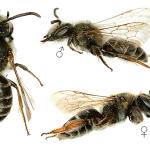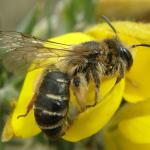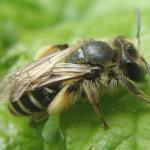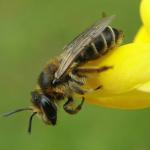Melitta ovatula Kirby, 1802, Andrena poupillieri Dours, 1872
A member of the subgenus Taeniandrena, represented in Britain by four species, A. ovatula is a very close relative of A. wilkella (Kirby) and is easily confused with that species, especially in the field. The two species are perhaps most readily distinguished in both sexes by the entire hair band on the third gastral tergite of A. ovatula (medially interrupted in A. wilkella)
Southern and central Britain from East Kent to the Isles of Scilly, northwards to Southeast Yorkshire and Cumberland. There are no records from Scotland, but it has been recorded from south-west Ireland (also from County Offaly according to O’Connor et al. (2009). In the Channel Islands, it is known from Guernsey and Alderney (Richards, 1979), Herm (Archer, 1994) and Sark (Beavis, 2000). Occasionally it is locally numerous in favoured open sites (see below).
In mainland Europe, the range extends from southern Fennoscandia south to southern Iberia, and east to Turkey (Gusenleitner & Schwarz, 2002). The species ranges across central Asia to China and the Far East (Yasumatsu, 1941). It is also known from North Africa (Morocco, Tunisia and Egypt) (Gusenleitner & Schwarz, 2002).
This species is not regarded as being scarce or threatened.
In contrast to its close sibling species, A. wilkella, this bee has a marked preference for gravelly or dry sandy soils, such as heaths and, on the coast, dunes, landslips and cliffs.
Generally bivoltine; end of March to late May or June, and again from June to mid September. However, its flight times in the year may be more complex. Chambers (1949) states that in Bedfordshire the first brood sometimes fails. Perkins (1919) was not certain whether there is a univoltine race that appears between the first and second generations of the more common form.
Nests do not seem to have been found in the British Isles. However, in eastern Europe, the species is reported to occasionally nest in large aggregations. There the favoured nesting sites are in sunlit slopes, less commonly in horizontal situations (Kocourek, 1966).
First brood: willow, blackthorn, pear, kidney vetch, common bird’s-foot-trefoil, gorse, ground-ivy, germander speedwell, dandelion. Second brood: thrift, bell heather, bramble, rest-harrow, gorse, thyme, sheep’s-bit.
No Nomada is known as a cleptoparasite of this species. Individuals are occasionally stylopised by Stylops thwaitei Saunders (Perkins, 1918).
2012





